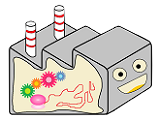Project Description
Tell us more about your project. Give us background. Use this as the abstract of your project. Be descriptive but concise (1-2 paragraphs)
References
iGEM teams are encouraged to record references you use during the course of your research. They should be posted somewhere on your wiki so that judges and other visitors can see how you though about your project and what works inspired you.
Content
You can use these subtopics to further explain your project
- Overall project summary
- Project Details
- Progress
- Materials and Methods
- The Experiments
- Results
- Data analysis
- Conclusions
It's important for teams to describe all the creativity that goes into an iGEM project, along with all the great ideas your team will come up with over the course of your work.
It's also important to clearly describe your achievements so that judges will know what you tried to do and where you succeeded. Please write your project page such that what you achieved is easy to distinguish from what you attempted.
Theme of our project
-
Transform new year's card to rice cake
(make cellulose resolve and reconstruct it to synthesize amylopectin)
-
RNA shaped like a ring / ring-shaped RNA
(mass-produce protein by ring-shaped RNA)
Description
-
In vivo, proteins are synthesized in transcription and translation.
Generally, mRNA is single-strand RNA, starting translation by binding ribosome on initiation codon, and ending by separating ribosome from mRNA.
In this study, we aim to build the method of synthesizing long-chain, massive proteins and to improve translation efficiency.
That is, allowing ribosomes to have a semi-permanent translation mechanism by producing circular mRNA and causing a defect of termination codon.
To cyclize mRNA, we can use a splicing mechanism of T4 phage.
Splicing is a mechanism removing circular introns which don't code for proteins and joining in exons which code for ones.
It occurs after transcription.
Splicing is catalyzed by several base sequences of the ends of introns as a ribozyme, being subjected to nucleophilic attack from introns to exons.
So we will introduce the plasmids which place the sequence of the end of introns as a splicing ribozyme on the end of a gene coding for proteins into E.coli, and cyclize mRNA for
synthesis of long-chain, massive proteins.







